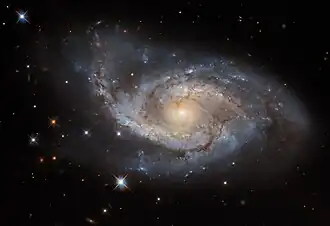NGC 3318
| NGC 3318 | |
|---|---|
 NGC 3318 imaged by the Hubble Space Telescope | |
| Observation data (J2000 epoch) | |
| Constellation | Vela |
| Right ascension | 10h 37m 15.5036s[1] |
| Declination | −41° 37′ 38.859″[1] |
| Redshift | 0.009255±0.000021[1] |
| Heliocentric radial velocity | 2,775±6 km/s[1] |
| Distance | 122.47 ± 2.40 Mly (37.550 ± 0.735 Mpc)[1] |
| Group or cluster | NGC 3318 group (LGG 199) |
| Apparent magnitude (V) | 12.19[1] |
| Characteristics | |
| Type | SAB(rs)b[1] |
| Size | ~114,400 ly (35.09 kpc) (estimated)[1] |
| Apparent size (V) | 2.4′ × 1.3′[1] |
| Other designations | |
| ESO 317- G 052, IRAS 10350-4122, MCG -07-22-026, PGC 31533[1] | |
NGC 3318 is a barred spiral galaxy in the constellation of Vela. Its velocity with respect to the cosmic microwave background is 3,077±22 km/s, which corresponds to a Hubble distance of 148.0 ± 10.4 Mly (45.38 ± 3.19 Mpc).[1] However, 20 non-redshift measurements give a much closer mean distance of 122.47 ± 2.40 Mly (37.550 ± 0.735 Mpc).[2] It was discovered by British astronomer John Herschel on 2 March 1835.[3][4]
NGC 3318 is a Seyfert II galaxy, i.e. it has a quasar-like nucleus with very high surface brightnesses whose spectra reveal strong, high-ionisation emission lines, but unlike quasars, the host galaxy is clearly detectable.[5]
NGC 3318 group
NGC 3318 is part of a galaxy group that bears its name. The NGC 3318 group (also known as LGG 199) has at least 9 galaxies, including NGC 3250, NGC 3250E, NGC 3250B, NGC 3318B, ESO 317-17, ESO 317-19, ESO 317-21, and ESO 317-23.[6]
Supernovae
Three supernovae have been observed in NGC 3318:
- SN 2000cl (Type IIn, mag. 14.8) was discovered by French amateur astronomer Robin Chassagne (bio-fr) on 26 May 2000.[7][8]
- SN 2017ahn (Type II, mag. 18.0896) was discovered by the Distance Less Than 40 Mpc Survey (DLT40) on 8 February 2017.[9]
- SN 2020aze (Type II, mag. 17.1224) was discovered by DLT40 on 26 January 2020.[10]
See also
References
- ^ a b c d e f g h i j k "Results for object NGC 3318". NASA/IPAC Extragalactic Database. NASA and Caltech. Retrieved 4 August 2025.
- ^ "Distance Results for NGC 3318". NASA/IPAC EXTRAGALACTIC DATABASE. NASA. Retrieved 4 August 2025.
- ^ Herschel, John. F. W (1864). "Catalogue of Nebulae and Clusters of Stars". Philosophical Transactions of the Royal Society of London. 154: 1–137. Bibcode:1864RSPT..154....1H. doi:10.1098/rstl.1864.0001.
- ^ Seligman, Courtney. "New General Catalogue Objects: NGC 3318". Celestial Atlas. Retrieved 4 August 2025.
- ^ "NGC 3318". SIMBAD. Centre de données astronomiques de Strasbourg. Retrieved 4 August 2025.
- ^ Garcia, A. M. (1993). "General study of group membership. II. Determination of nearby groups". Astronomy and Astrophysics Supplement Series. 100: 47. Bibcode:1993A&AS..100...47G.
- ^ Chassagne, R.; Maury, A.; Vanzi, L.; Testi, L.; Lidman, C. (2000). "Supernova 2000cl in NGC 3318". International Astronomical Union Circular (7432): 1. Bibcode:2000IAUC.7432....1C.
- ^ "SN 2000cl". Transient Name Server. IAU. Retrieved 4 August 2025.
- ^ "SN 2017ahn". Transient Name Server. IAU. Retrieved 4 August 2025.
- ^ "SN 2020aze". Transient Name Server. IAU. Retrieved 4 August 2025.
External links
 Media related to NGC 3318 at Wikimedia Commons
Media related to NGC 3318 at Wikimedia Commons- NGC 3318 on WikiSky: DSS2, SDSS, GALEX, IRAS, Hydrogen α, X-Ray, Astrophoto, Sky Map, Articles and images